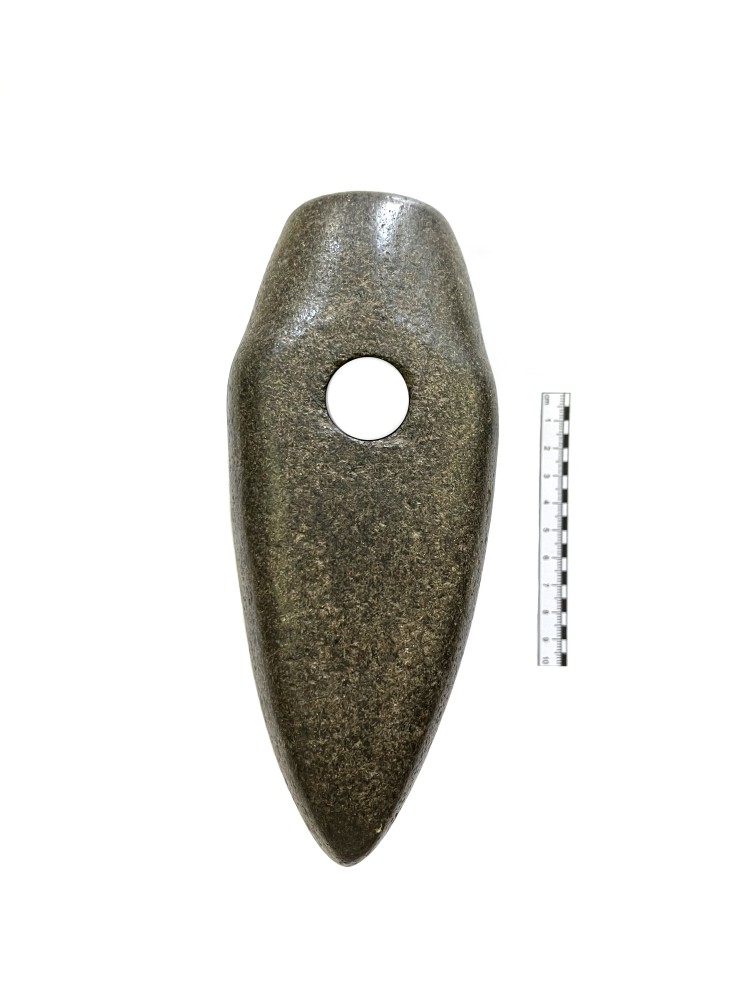#Exhibit of the Month
>>>

The artifact is a battle axe made from magmatic rock (diabase) of gray-brown color. It was accidentally discovered in 1966 within the territory of Aluniș village, Rîșcani district. Based on its morphological characteristics, the artifact can be attributed to the Catacomb culture (29th-22nd centuries BCE). The axe features a massive, elongated naviform body with slightly pronounced shoulders, a short and narrow edge that is flat and circular in cross-section. The blade is slightly curved. The hole was drilled in the maximum width of the object. It is circular in shape with a diameter of 2.2 cm. The surface of the artifact is meticulously polished, worked with great care, and shows no signs of damage or chipping. Dimensions: Length: 20.0 cm; Maximum width: 8.4 cm; Edge diameter: 5.0 cm; Blade width: 7.0 cm; Weight: 2.3 kg. Stone battle axes are characteristic of the Catacomb culture communities and are most often found as grave goods, deposited in tombs. Their presence in funerary complexes suggests a multifaceted functionality: weapons, social symbols, and ritual objects. Initially used as weapons, the axes became social symbols for their owners, later acquiring votive significance when deposited in tombs to serve the deceased in the afterlife. The social symbolic function of stone battle axes is indicated by the high-quality rocks used for their manufacture and the exceptionally meticulous craftsmanship. The large dimensions of the axe from Aluniș support this hypothesis and distinguish it from other examples. The discovery of stone battle axes outside a funerary complex may indicate their votive deposition. It is difficult to imagine that these exceptionally well-crafted pieces, made from high-quality rocks transported over great distances, could have been abandoned or lost accidentally. It is far more likely that they were deposited for magical-religious purposes, a possibility that may also apply to the stone axe discovered at Aluniș.

Virtual Tour
|

|
|
|
 |
  Events Archive Events Archive
Vernissage of the Floral Art Exhibition "Bloom, Moldova!"
July 11, 2024
On Thursday, July 10, 2024, the National Museum of History of Moldova hosted the vernissage of the floral art exhibition "Bloom, Moldova!" This event was dedicated to celebrating 33 years of activity of the "Diana" Floristry Club, the only club of its kind in the country. The exhibition, organized in partnership with the club, gathered a significant number of visitors eager to admire the talent and craftsmanship of the floral artists. The vernissage began with an exhibition presentation by the club's director, Lilia Marjina, who provided details about the oshibana technique used in creating the works, as well as the remarkable journey of the "Diana" Floristry Club over its 33 years of activity. This was followed by speeches from museum museographers and club representatives, who emphasized the importance of promoting floral art and the talent of local artists. A distinctive element of the exhibition is the diversity of the works displayed, each one a testament to the talent and creativity of the club members. From delicate floral arrangements to complex floral sculptures, the exhibition offers a fascinating glimpse into the world of Japanese floral art, demonstrating the artists' mastery in using natural materials and transforming them into unique works of art. During the vernissage, visitors had the opportunity to admire the 68 works created by the 8 club members, exhibited in the ground floor hall of the museum. The exhibition "Bloom, Moldova!" will be open for visitation from July 11 to August 1, 2024, in the ground floor hall of the National Museum of History of Moldova (Chișinău, 31 August 1989 Street, 121A).
|
 |
|
| |
 |
|
#Exhibit of the Month

The artifact is a battle axe made from magmatic rock (diabase) of gray-brown color. It was accidentally discovered in 1966 within the territory of Aluniș village, Rîșcani district. Based on its morphological characteristics, the artifact can be attributed to the Catacomb culture (29th-22nd centuries BCE)...
Read More >>
The National Museum of History of Moldova takes place among the most significant museum institutions of the Republic of Moldova, in terms of both its collection and scientific reputation.
©2006-2025 National Museum of History of Moldova
 31 August 1989 St., 121 A, MD 2012, Chisinau, Republic of Moldova
Phones: 31 August 1989 St., 121 A, MD 2012, Chisinau, Republic of Moldova
Phones:
Secretariat: +373 (22) 24-43-25
Department of Public Relations and Museum Education: +373 (22) 24-04-26
Fax: +373 (22) 24-43-69
E-mail: office@nationalmuseum.md
Technical Support: info@nationalmuseum.md
Web site administration and maintenance: Andrei EMILCIUC
|
| |
